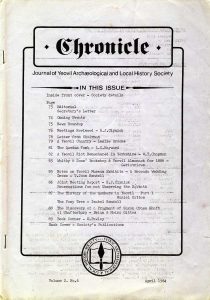The Quedam Tomb
This article came from the Chronicle published April 1984. Pages 81-82
THE QUEDAM TOMB
Author: L.C.Hayward
Work on the Quedam development at the top of Vicarage Street on 27th September 1983 revealed a brick-tomb containing a lead-lined coffin about three feet below the then street level. The site engineer reported the discovery to the police, who arranged the removal of the’ coffin to the mortuary at Yeovil Hospital. Thanks to the co-operation of Mr.Stevens and the medical staff, the skeleton was identified as that of an adult male about 40 years old, just over six feet tall. Traces of his ginger-brown, wavy hair survived; his teeth were well preserved, though showing a greater degree of wear on the right-hand side. This was probably a consequence of chewing mainly on that side, for the trace of an abscess was noticed on the left.Only two teeth had been extracted. The skeleton, together with the skulls of two adult females found nearby, was reburied in Yeovil cemetery.
The discovery was made on the site of a Unitarian Church which became part of Winsor’s agricultural machinery premises and was finally demolished a few years ago to make way for a car park. This church, built in 1893, was the third to be erected there by the Unitarians, who were founded in Yeovil by Henry Butler, after his eviction as vicar of St John’s on the restoration of Charles II. The sect acquired the Vicarage Street site in 1704: it had formerly been the property of one of the Chantry Chapels in the church, and the first Unitarian Church was built there soon afterwards. This church, marked on the 1806 map, was set further back from the street frontage, thus making possible a small burial ground in front of the building. It is clear that the Quedam burials took place here.
Dissenters usually had their own burial grounds, such as the Baptists at Odcombe, the Quakers in Preston Road and the Calvinists in Huish. Readers of Chronicle will recall the discovery of a Unitarian burial ground in Mudford Road (Vol.2, no.3, p.34). Interments of prominent people were made however in front of Nonconformist chapels, such as that recorded in Chronicle, (Vol.1, no.2, p.6) of Mrs Elizabeth Hookins at the Congregational Church, Princes St. Daniel Vickery in his sketch of Yeovil (1856) mentions a memorial tablet to a Mr.Bartlett, Minister, outside the Unitarian Church in Vicarage Street, probably the Robert Bartlett named by Densham and Ogle in “The Story of Congregational Churches of Dorset”; he was called to Yeovil in 1688, and in 1710 was buried between the doors of the church, aged 70. He was therefore too old to have occupied the Quedam tomb.
A more likely candidate is Robert Batten, the second son of Nathaniel Butler Batten. The latter is named in Unitarian documents at Taunton Record Office as the only surviving trustee in 1784 of the Unitarian Church in Vicarage Street, he died in the following year aged 72, and though known to have been buried in Yeovil, he is clearly not the person buried in the-tomb because of his age. His sons, Nathaniel and Edmund, died in Yeovil aged 76 and 86 respectively, but Robert, born c.1748 and still living in Yeovil in 1779, could have died before the end of the 18th century. The date of his,death is unknown, but he is the likeliest candidate for the Quedam burial, for his family was wealthy enough to afford such an elaborate tomb.
The writer gladly acknowledges the help of Mr. and Mrs. Gittos in his investigation of this problem, especially the lead coffin: it was enclosed in a wooden coffin, a few fragments surviving together with hand-made iron nails. An iron handle found nearby may have belonged to it. The lead lining was constructed from a single sheet of metal, for there were joints at each corner but not where the sides met the bottom. There were three drainage holes in the floor of the coffin. The metal was virtually pure lead, and except for the lid, was well preserved. The lid was sealed to the sides of the coffin rather like-a pie-crust. Its badly corroded condition and the presence of calcium salts with corrosion products could be explained by the action of water seeping through the domed brickwork of the tomb.
